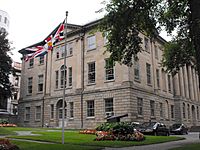Heritage Property Act (Nova Scotia) facts for kids
Quick facts for kids Heritage Property Act |
|
|---|---|

Province House, where Nova Scotia's legislature meets, was designated a Provincially Registered Property under the Heritage Property Act in 1983
|
|
| An Act to Provide for the Identification, Preservation and Protection of Heritage Properties | |
| Citation | R.S. 1989, c. 199 (amendments 1991, c. 10; 1998, c. 18, s. 561; 2010, c. 54) |
| Territorial extent | Nova Scotia |
| Enacted by | Nova Scotia House of Assembly |
| Date enacted | 1980 |
The Heritage Property Act is a special statute (or law) in Nova Scotia, Canada. This law helps to find, protect, and restore important historical and cultural places. These places are known as cultural heritage properties.
Contents
Protecting Nova Scotia's History
The Heritage Property Act helps keep Nova Scotia's past alive. It makes sure that buildings, areas, and landscapes that tell a story about history are looked after. This way, future generations can learn from and enjoy them.
What is the Heritage Property Act?
This Act is a provincial law. This means it applies only to the province of Nova Scotia. Its main goal is to identify, preserve, and protect properties that have special historical or cultural value. It helps make sure these places are not lost or damaged.
How Does the Act Protect Heritage?
The Act offers five main ways to protect heritage properties. These different types of protection help to save various kinds of historical sites.
- Provincial Registry of Heritage Properties: This is a list of places that the provincial government believes are very important to Nova Scotia's history. Once a property is on this list, it gets special protection.
- Provincial Cultural Landscape: Sometimes, a whole area, not just one building, has historical value. This could be a special garden, a historic farm, or a traditional village. If it's listed on the Provincial Registry, it's called a Provincial Cultural Landscape.
- Municipal Registries of Heritage Properties: Local towns or cities (called municipalities) can also make their own lists. These lists include properties that are important to their local community's history.
- Municipal Heritage Conservation Districts: A municipality can mark off a specific area as a "heritage district." This means the whole neighborhood has a unique historical feel. Special rules help keep the district's character, even if new buildings are added.
- Municipal Cultural Landscapes: Similar to provincial cultural landscapes, these are local areas with historical or cultural importance. They are listed on a Municipal Registry.
A Look Back: When Did the Act Start?
The Heritage Property Act was first created in 1980. Since then, it has been updated a few times. Changes were made in 1991, 1998, and 2010. These updates help the Act stay current and effective.
Other Laws That Help Protect Special Places
Nova Scotia has other laws that work alongside the Heritage Property Act.
- The Special Places Protection Act helps protect archaeological sites. These are places where people can find old artifacts or remains from the past. It also protects natural sites, like unique forests or coastlines.
- The Cemeteries Protection Act helps protect burial grounds and cemeteries. This ensures that these important historical and sacred sites are respected and preserved.

